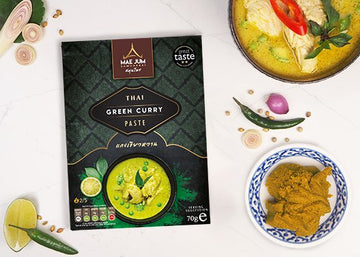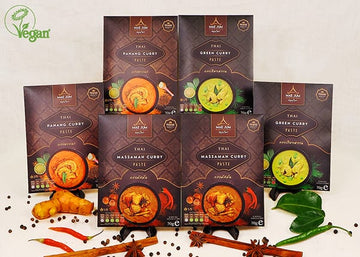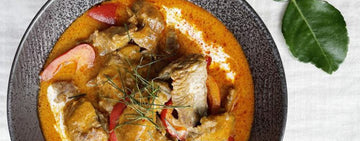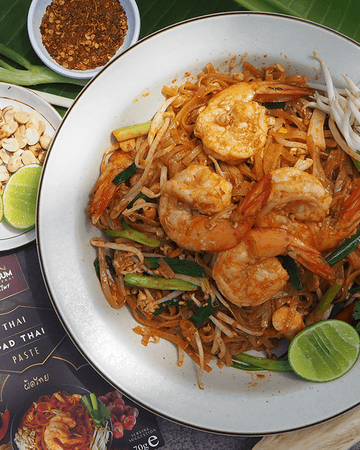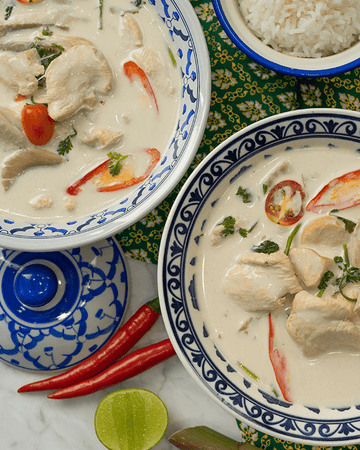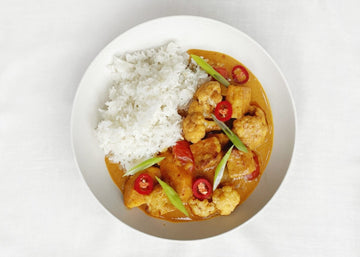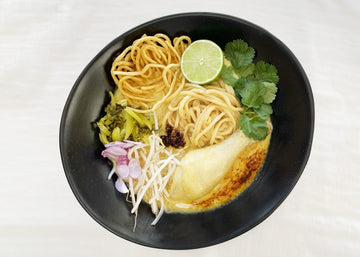Beef Panang Curry is one of the stars of this genre, balancing sweetness and creaminess with just a gentle hint of spice. It’s the perfect dish to introduce someone to Thai flavours without overwhelming them. The dish's depth lies in the sauce, which is thicker and more robust than other curries. The sauce reduction gives it a "muddy" texture that clings beautifully to the beef, creating an incredibly satisfying meal.
What Makes Panang Curry Unique?
Panang curry, also known as Phanaeng, originates from central Thailand and shares similarities with traditional red curry. However, Panang curry tends to be sweeter and thicker, with a more subdued heat. The sweetness in Panang comes from coconut milk and palm sugar, while the richness is achieved through the slow reduction of the sauce, which allows the flavours to intensify and meld together.
What truly sets Panang curry apart is the use of kaffir lime leaves. These leaves have a distinct, citrusy aroma that elevates the dish, adding a burst of freshness. Although kaffir lime is present in the curry paste, fresh leaves enhance the flavour, bringing a unique lemony note that cannot be substituted with lime juice.
The Key Ingredients
Panang curry is built around a few essential ingredients that define its flavour and texture. Here’s a look at the main components of this delicious dish:
- Panang Curry Paste: The base of this dish is the Panang curry paste, typically made from red chillies, lemongrass, galangal, kaffir lime rind, cumin, coriander seeds, and shrimp paste. The blend of these spices creates a fragrant and flavourful base that defines the curry.
- Beef: The beef used in this dish is typically a tender cut that cooks quickly, such as sirloin or flank steak. The beef is sliced thinly so that it cooks evenly and absorbs the flavours of the sauce.
- Coconut Milk: Coconut milk is a key ingredient in Panang curry, adding richness and creaminess. The thick, creamy layer from the top of the coconut milk is used to fry the curry paste and loosen it up, creating a luxurious sauce.
- Fish Sauce and Palm Sugar: These ingredients are essential for balancing the flavours. Fish sauce adds saltiness and depth, while palm sugar brings a subtle sweetness that contrasts with the spices.
- Kaffir Lime Leaves: Fresh kaffir lime leaves add a burst of citrus flavour and are an important garnish in Panang curry. They provide the dish with its signature zesty aroma and should not be substituted with lime juice, which would add unnecessary sourness.

How to Make Thai Beef Panang Curry
Now that we understand the key ingredients, let’s walk through how to make this delicious Beef Panang Curry at home.
- Preparation: The great thing about this dish is that it requires minimal preparation. Start by slicing the beef into thin strips to ensure quick and even cooking. It’s important to have all your ingredients prepared and ready before you start cooking, as this dish comes together quite quickly.
- Cooking the Curry Paste: Heat a tablespoon of oil in a large saucepan or wok over medium-high heat. Once hot, add the Panang curry paste and stir-fry for 2-3 minutes until fragrant. You’ll notice the aroma as the spices release their oils, creating a rich base for the curry.
- Adding Coconut Milk: Scoop the thick layer of coconut cream from the top of an unshaken can of coconut milk and add it to the wok. Stir the coconut cream with the curry paste to loosen the paste and form a smooth sauce. Let the mixture simmer for a few minutes, allowing the flavours to develop.
- Seasoning: Add a tablespoon of fish sauce and a teaspoon of palm sugar to the wok. Stir well and let the sauce simmer for around 5 minutes. At this stage, you should begin to see the oils from the coconut milk rise to the surface of the sauce. This is a good sign that the curry is reducing and intensifying in flavour.
- Cooking the Beef: Add the sliced beef to the wok, stirring it into the sauce so that it’s fully coated. Cook for about 5 minutes, or until the beef is just cooked through. Be careful not to overcook the beef, as you want it to remain tender.
- Final Touches: Pour in the remaining coconut milk and let the curry simmer for another 10-15 minutes to thicken. At this point, you can add sliced red chillies for an extra kick of heat, or leave them out if you prefer a milder flavour. Garnish the curry with thinly sliced kaffir lime leaves for a fresh, citrusy finish.
- Serving: Serve the Beef Panang Curry with freshly steamed Thai jasmine rice. The fragrant rice is the perfect accompaniment to the rich, creamy curry sauce. You can also add a wedge of lime on the side for a touch of acidity to brighten up the dish.

The Balance of Flavours in Panang Curry
One of the most impressive aspects of Thai Panang Curry is its ability to balance different flavours. Thai cuisine is renowned for its harmony between sweet, salty, spicy, and sour elements, and Panang curry is no exception.
- Sweetness: The sweetness comes from palm sugar and coconut milk. Palm sugar adds a rich, caramel-like sweetness that is more subtle than regular sugar, while coconut milk provides a creamy base that mellows out the spice.
- Saltiness: The addition of fish sauce gives the dish a salty, umami punch that balances the sweetness and enhances the flavour of the beef.
- Spice: Although Panang curry is milder than some other Thai curries, it still has a hint of heat from the red chillies in the curry paste. If you love spice, you can always add more fresh chillies or a pinch of chilli flakes.
- Citrus: The final touch of kaffir lime leaves brings a burst of fresh citrus flavour that cuts through the richness of the sauce and lifts the entire dish.
Garnishes and Serving Suggestions
While Panang curry is already delicious on its own, garnishing the dish adds texture and additional layers of flavour. Here are a few ideas for garnishing and serving Beef Panang Curry:
- Sliced Red Chillies: For those who enjoy a bit more spice, adding fresh red chillies can bring extra heat and a pop of colour.
- Kaffir Lime Leaves: As mentioned, kaffir lime leaves are essential for adding a fresh, zesty note to the dish. Thinly slice the leaves and sprinkle them over the curry just before serving.
- Crushed Peanuts: A sprinkle of crushed peanuts adds crunch and an extra layer of richness that complements the creamy sauce.
- Lime Wedges: While lime juice should not be added to the curry, serving lime wedges on the side allows diners to add a squeeze of fresh lime to their liking, brightening up the dish.
- Steamed Vegetables: Panang curry is often served with a side of steamed vegetables like broccoli, baby corn, or bok choy, which add a refreshing contrast to the richness of the curry.
Final Thoughts
Thai Beef Panang Curry is a dish that perfectly exemplifies the beauty of Thai cuisine. Its rich, creamy sauce, balanced with sweet, salty, and spicy elements, makes it a favourite among those who love flavourful, aromatic dishes. Despite its impressive complexity, Panang curry is surprisingly easy to make at home, requiring only a handful of ingredients and less than 30 minutes of cooking time.
Whether you’re new to Thai cooking or a seasoned pro, Beef Panang Curry is a dish that’s sure to impress. Its luxurious texture and harmonious flavours make it a go-to recipe for both special occasions and weeknight meals. Serve it with jasmine rice and a few simple garnishes for a meal that will transport you straight to the heart of Thailand.

If you enjoyed our Thai Beef Panang Curry recipe, please give this recipe a star rating and comment if you loved the flavours of this traditional Thai dish! Check out our recipe page for more delicious dishes like this and subscribe for new recipes and posts. Always stay connected and follow us on Instagram and Facebook!
